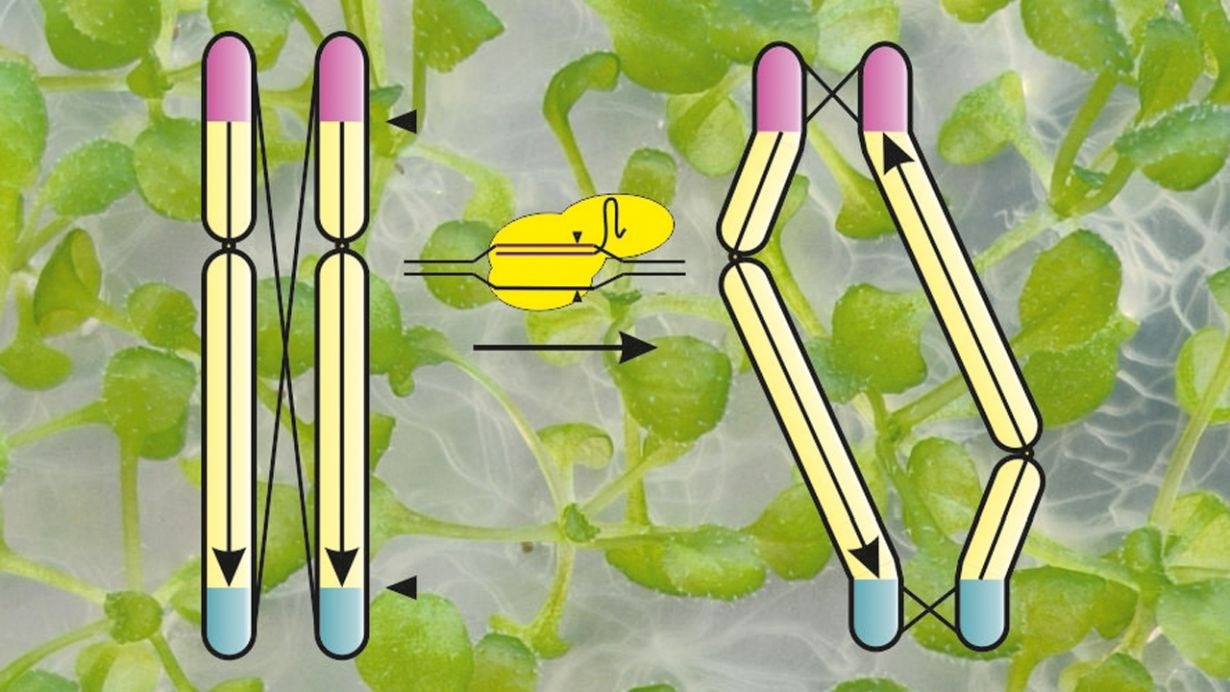Reviewed by Danielle Ellis, B.Sc.Sep 21 2022
The use of CRISPR/Cas (Clustered Regularly Interspaced Short Palindromic Repeats) molecular scissors enables targeted editing, insertion, or suppression of genes in plants. This technique helps in making the plants highly resistant to diseases, pests, or environmental influences.
 Genetic exchange of paternal and maternal characteristics normally occurs along the entire length of a chromosome. Through inversion of most of the chromosome (yellow) with CRISPR/Cas molecular scissors, this exchange can now be limited to the extreme ends (violet and blue). Image Credit: Michelle Rönspies, Karlsruhe Institute of Technology
Genetic exchange of paternal and maternal characteristics normally occurs along the entire length of a chromosome. Through inversion of most of the chromosome (yellow) with CRISPR/Cas molecular scissors, this exchange can now be limited to the extreme ends (violet and blue). Image Credit: Michelle Rönspies, Karlsruhe Institute of Technology
In recent years, we were able for the first time to use CRISPR/Cas not only to edit genes but also to change the structure of chromosomes. Genes are linearly arranged along chromosomes. By changing their sequence, we were able to show how desired traits in plants can be separated from undesired ones.”
Holger Puchta, Professor, Botanical Institute, Karlsruhe Institute of Technology
Holger Puchta has been researching the applications for gene scissors with his team for the past three decades.
Scientists can now impede the genetic exchange that is generally a part of the hereditary process but can sever the ties between traits.
We can shut down a chromosome almost completely, making it seem invisible, so that all traits on that chromosome can be passed on in a package.”
Holger Puchta, Professor, Botanical Institute, Karlsruhe Institute of Technology
The genes responsible for a plant’s traits have to be closer to one another on the same chromosome for the characteristics to be handed down together. A desirable characteristic might be lost because of breeding if such genes are spaced apart on a chromosome as they are particularly divided during inheritance.
Learning from nature: Chromosome engineering prevents genetic exchange
The investigators, in their study, pursued nature’s example.
These reversals, or inversions—a kind of genetic invisibility—also occur frequently on a smaller scale in wild and cultivated plants. We’ve learned from nature and have applied and extended our knowledge about the natural process.”
Holger Puchta, Professor, Botanical Institute, Karlsruhe Institute of Technology
Puchta and his group, along with Professor Andreas Houben from the Leibniz Institute of Plant Genetics and Crop Plant Research (IPK), inverted nine-tenths of a chromosome in the model organism Arabidopsis thaliana (thale cress). The genes retained their original sequence only at the ends of the chromosome.
Puchta says, “With these fragments, the chromosome can be passed on to the next generation just like the other chromosomes and is not completely lost.”
Enabling future cultivation of more efficient and more robust crop plants
To effectively breed crops, it is vital to incorporate numerous favorable characteristics as possible in a single plant.
Puchta concludes, “Of course plant breeders want their products to taste good, have as many vitamins as possible and also be resistant to disease. With our method, we can make that easier in the future.”
Source:
Journal reference:
Rönspies, M., et al. (2022) Massive crossover suppression by CRISPR–Cas-mediated plant chromosome engineering. Nature Plants. doi.org/10.1038/s41477-022-01238-3.